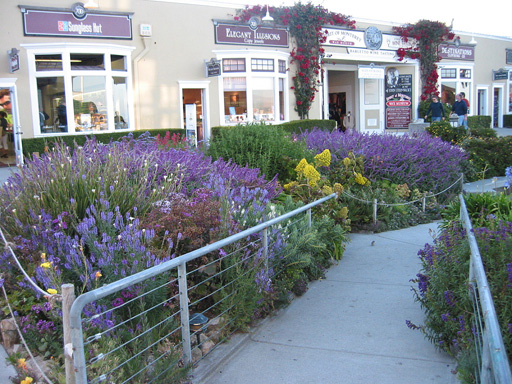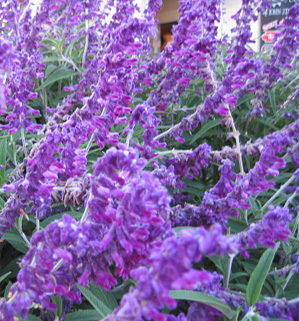Shades of Purple!
From the Davis Enterprise, June 22, 2006
I was traveling recently along the coast of Monterey, thanks to a family graduation, and we decided to be tourists for an afternoon. Wandering along Cannery Row my attention was arrested by a lovely, well-composed perennial garden in the middle of a public plaza (needless to say, this kind of thing drives my family nuts). Public areas in Monterey are incredibly well landscaped with colorful shrubs and perennials (Public Works Department, take note!). But what struck me was that, either by design or by chance, the planting was nearly monochromatic in the use of purple.

I began to notice that most of the showiest flowers in the area were in shades of purple and pink. It's a color choice that is automatically elegant, with a cool effect. Never jarring, always tasteful even when overflowing with flowers. Purple, lavender, and blue are the workhorses of the landscape: great in mass plantings, perfect for contrast or as a foil for yellow and orange flowers – or grey foliage.
The backbone of this particular planting was Salvia leucantha, the Mexican sage. This species seems to bloom nearly year around in coastal areas. Inland it begins blooming in fall and continues into the winter until freezing weather finally nips it back. There are lots of Salvias in shades of purple and lavender and blue (not to mention red, hot pink, pale yellow, and white). Some are spiky, others are leafy or floppy, and others have big bold-textured foliage.

Mexican sage has the advantage of a dense, shrubby habit, so the plant gives structure to the border even when it's out of bloom. It has vibrant, fuzzy royal purple flowers. Other shrubby purple Salvias include S. clevelandii, varieties of S. greggii, S. mexicana, S. microphylla, and the low-growing S. sinaloensis. All of the Salvias attract hummingbirds.
Two of the more spectacular plants in Monterey, attracting lots of attention even from non-plantophiles, are in the Mallow family—and both grow well in the Sacramento Valley. Blue hibiscus (Alyogyne huegelii) is a vigorous shrub growing to 8 – 10' +, with royal purple flowers shaped just like the better-known tropical hibiscus (which are cousins). One big difference: Blue hibiscus is hardy enough to grow in the Valley, while tropical Hibiscus rosa-sinensis is killed here.
Lavatera bicolor is also a large shrub, somewhat gangly, with blooms nearly nonstop from early spring through fall. Generally 6 – 8' range, with sometimes greater spread, with blossoms best described as rosy-lavender. My Lavatera bicolor is nearly always in bloom. Other species are available in shades of pink. Both Blue hibiscus and Lavatera look best if they are sheared lightly to improve plant density, and they bloom constantly even when pruned frequently.
In my own garden there is a season in which purple dominates. In May and early June two plants bloom prolifically together in one border, and suddenly I have a riot of royal purple. Clematis jackmani, a perennial vine, scrambles up over shrubs and then covers itself with 4-inch blooms.
 There are dozens of varieties. Most bloom in late spring or early summer, though some are fall-bloomers. Clematis vines do best where the roots are shaded and get regular watering, but the tops can take full sun.
The common name of Brunfelsia pauciflora describes the sequence as the flowers fade from purple to white: Yesterday-Today-and-Tomorrow shrub. The rest of the year this is a nice evergreen shrub for the shade. It is easily kept to 4', and appreciates seasonal feeding with an acid-type fertilizer.
There are dozens of varieties. Most bloom in late spring or early summer, though some are fall-bloomers. Clematis vines do best where the roots are shaded and get regular watering, but the tops can take full sun.
The common name of Brunfelsia pauciflora describes the sequence as the flowers fade from purple to white: Yesterday-Today-and-Tomorrow shrub. The rest of the year this is a nice evergreen shrub for the shade. It is easily kept to 4', and appreciates seasonal feeding with an acid-type fertilizer.
There are some other purple and blue flowers nearby in my shade border. Tradescantia andersoniana has unique 3-cornered purple blooms on a grassy-looking plant which gives a big late spring bloom. Vinca minor and Vinca major are periwinkles, their spring flowers being the origin of the color name 'periwinkle blue'. Turf lily (Liriope muscari) has flowers the color of grape juice that resemble Grape hyacinths (Muscari armeniacum, hence the species name 'muscari' for the Liriope; taxonomists are sometimes helpful this way). And one of the toughest ground-covering perennials for shade or partial sun is dwarf Plumbago (Ceratostigma plumbaginoides), with true blue flowers all summer long.
Those are all in the shade. One of the classic namesake purple flowers can grow in full, hot, blazing sun: Lavender. Lavenders (Lavandula officinalis is the classic English lavender) and lavandins (hybrid lavenders) are attractive shrubs all year long, most with grey foliage and a dense enough habit to make them backbone shrubs for the sunny border. Lavenders produce rich purple, lavender, or even pale pink or white flowers in May – June. Lavandins bloom in June – July. The varieties 'Provence' and 'Grosso' are grown for their powerfully fragrant blossoms. Others such as French lavender (L. dentata) have fragrant foliage. Spanish lavender (L. stoechas) blooms very early and much longer than other types. Keep all lavenders on the dry side, as they are prone to rot if watered too often.
Want more purple in your garden right now? Here are some more that bloom late spring to summer:
Agapanthus(Lily of the Nile)
Ubiquitous perennial. Lots of new varieties, including some very intense purple-flowered types. Sun or light shade.
Ajuga reptans (Carpet bugle)
Bronze or green-leaved ground cover for dryish shade.
Convolvulus mauritanicus (Bush morning glory)
One of my favorites, giving perfect miniature morning glory flowers on a non-invasive plant; tough, tolerant of sun or light shade.
Lobelia erinus (Lobelia)
Vivid blue-purple flowering annual.
Lobularia maritima (Sweet alyssum)
The variety 'Royal Carpet' is one of the easiest, fastest ways to get purple in the garden in any season. Reseeds prolifically, but reverts gradually to white over several generations.
Lycianthes rantonnetii (Purple potato vine)
Formerly Solanum rantonetti
Nepeta species and hybrids (Catmint)
Little mint-leaved shrublets with purple flowers, for sun or light shade.
Penstemon 'Midnight' (Summer snapdragon)
This variety has dark blue flowers, very attractive to hummingbirds, from May – July.
Plumbago capensis (Cape plumbago)
Shrubby/vining relative of the afore-mentioned Ceratostigma, for sun or light shade.
For a dramatic point of interest, you can intersperse small plantings of bright yellow flowers, or pair the purple flowers with silver-foliage plants such as Artemisias. Powis Castle is a great Artemisia for large gardens; Silver Mound is good for smaller plantings. Use purple and blue flowers in quantity to give more order to your garden design. This is the color of royalty!
© 2008 Don Shor, Redwood Barn Nursery, Inc., 1607 Fifth Street, Davis, Ca 95616
www.redwoodbarn.com
Feel free to copy and distribute this article with attribution to this author.
Click here for Don's other Davis Enterprise articles
